Electromagnetic Induction
Question 1. A coil of resistance 400 Ω. is placed in a magnetic field. If the magnetic flux Φ (Wb) linked with the coil varies with time t (s) as Φ = 50t2 + 4, the current in the coil at t = 2 s is
- 0.5 A
- 0.1 A
- 2A
- 1A
Answer: 1. 0.5 A
Induced emf = \(\varepsilon=\left|\frac{d \phi}{d t}\right|=\frac{d}{d t}\left(50 t^2+4\right)=100 t \mathrm{~V}\)
∴ Current = I = \(\frac{\varepsilon}{R}=\frac{(100 \times 2) \mathrm{V}}{400 \Omega}=0.5 \mathrm{~A}\).
Question 2. The magnetic flux linked with a coil is given (in Weber) by the equation Φ = 5t2+3t-l6. The induced emf in the coil in the fourth second will be
- 210 V
- 10 V
- 108 V
- 145 V
Answer: 2. 10 V
Magnetic flux = Φ = (5t2 + 3t-16) Wb.
⇒ Induced emf = \(\varepsilon=\left|\frac{d \phi}{d t}\right|=\frac{d \phi}{d t}=(10 t+3) \mathrm{V}\)
At t= 3 s, ε1 = (30+ 3) V= 33 V.
At t= 4 S, ε2 = (40+ 3) V = 43 V
∴ Induced emf in the 4th second, ε – ε2– ε1 = 43 V – 33 V = 10 V.
Question 3. A long solenoid has 1000 turns. When a current of 4.0 A flows through it, die magnetic flux linked with each turn of the solenoid becomes 4 x10-3 Wb. The self-inductance of the solenoid is
- 3H
- 4H
- 1H
- 2H
Answer: 3. 1H
Magnetic flux (Φ) linked with a coil is proportional to the current (I) through it,
i.e., Φ ∝ I or ty = LI.
Here Φ = NΦ0 = (1000)(4 x10-3 Wb)= 4 Wb
\(L=\frac{\phi}{I}=\frac{4 \mathrm{~Wb}}{4.0 \mathrm{~A}}=1.0 \mathrm{H}\).
Question 4. The adjoining figure shows a conducting circular loop of radius r placed near a long straight wire carrying a steady current I. Which of the following options is true?
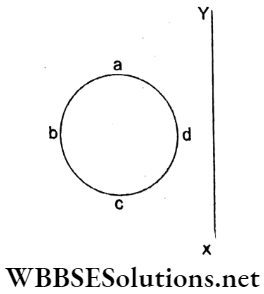
- The induced current will be clockwise.
- The induced current will be anticlockwise.
- The induced current will change periodically.
- No current will be induced.
Answer: 4. No current will be induced.
When a steady current flows through the conductor XY, the magnetic field \(\left(B=\frac{\mu_0 I}{2 \pi r}\right)\) also be steady. Hence, the magnetic flux linked with the circular loop will not vary with time, thus the emf induced will be zero and no current will flow through the loop.
Question 5. A rectangular conducting loop is placed coplanar near a long straight wire carrying a current 7. If the current increases continuously then which of the given options will be true for the current induced in the loop?
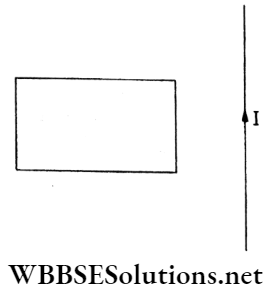
- The induced current will be clockwise.
- The induced current will be anticlockwise.
- No current is induced.
- The direction of the induced current will change periodically.
Answer: 1. The induced current will be clockwise.
When current I flow through the straight conductor, the magnetic field produced will be directed perpendicularly out of the plane of the loop and magnetic flux will be linked. With the continuous increase in I, magnetic flux will also increase. According to Lenz’s law, the induced
current will be directed clockwise to oppose the increasing flux.
Question 6. A conducting circular loop having 10 turns is placed in a uniform magnetic field B = 0.04 T with its plane perpendicular to the magnetic field. Assume that the radius of the loop starts shrinking at a constant rate of 2.0 mm s-1. The induced emf in the loop at an instant when its radii are 4 cm will be approximately
- 2 μ V
- 40 μ V
- 200 μ V
- 400 μ V
Answer: 3. 200 μ V
Instantaneous flux through the circular loop is
Φ = NAB ⇒ Φ = N(πR2)B.
∴ \(\frac{d \phi}{d t}=(N \pi B) 2 R \frac{d R}{d t}\).
Hence, induced emf = \(\varepsilon=\frac{d \phi}{d t}=2 \pi N B R \frac{d R}{d t}\).
Given, B = 0.04 T, N =10, R = 4 x 10-2 m
⇒ and \(\frac{d R}{d t}=2.0 \mathrm{~mm} \mathrm{~s}^{-1}=2.0 \times 10^{-3} \mathrm{~m} \mathrm{~s}^{-1}\)
Substituting the values,
ε = 2(3.14)(10)(0.04 T)(4 x 10-2 m)(2 x 10-3 ms-1)
= 20 x 10-5 V= 200 pV.
Question 7. A square loop ABCD carrying a steady current I1 is placed coplanarly near a long straight conducting wire XY which carries a steady current I2. The net force on the loop will be
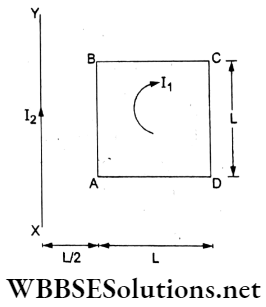
- \(\frac{\mu_0 I_1 I_2}{2 \pi}\)
- \(\frac{2 \mu_0 I_1 I_2 L}{3 \pi}\)
- \(\frac{\mu_0 I_1 I_2 L}{2 \pi}\)
- \(\frac{2 \mu_0 I_1 I_2}{3 \pi}\)
Answer: 4. \(\frac{2 \mu_0 I_1 I_2}{3 \pi}\)
The magnetic field around AB due to straight current is
⇒ \(B_1=\frac{\mu_0 I_2}{2 \pi(L / 2)}=\frac{\mu_0 I_2}{\pi L}\)
The force of attraction on AB (towards the left) is
⇒ \(F_1=I_1 B_1 L=\frac{\mu_0 I_1 I_2}{\pi}\)
Similarly, the force of repulsion (F2) on CD is
⇒ \(F_2=I_1 B_2 L=I_1\left(\frac{\mu_0 I_2 L}{2 \pi(3 L / 2)}\right)=\frac{\mu_0 I_1 I_2}{3 \pi}\).
The net force on the loop is
⇒ \(F=F_1-F_2=\frac{\mu_0 I_1 I_2}{\pi}\left(1-\frac{1}{3}\right)=\frac{2}{3} \frac{\mu_0 I_1 I_2}{\pi}\).
Forces on BC and AD are equal and opposite, hence do not contribute to the net force.
Question 8. At a place the earth’s magnetic field 4 x 10-5 Wb m-2 is directed perpendicular to the plane of a conducting coil of radius R = 5 cm. If \(\frac{\mu_0}{4 \pi}=10^{-7} \mathrm{TmA}^{-1}\), how much current is induced in the circular loop?
- 40 A
- 4 A.
- 0.4 A
- 0 A
Answer: 4. 0 A
Magnetic flux linked with the coil is Φ = BA which is constant in the given question. Hence, there will be no induced emf and no induced current.
Question 9. A circular coil of radius 10 cm, 500 turns, and resistance 2 Q is placed with its plane perpendicular to the horizontal component of the earth’s magnetic field. It is rotated about its vertical diameter through 180° in 0.25 s. The current induced in the coil is (a horizontal component of the earth’s magnetic field at that place is 3.0 x10-5 T)
- 1.9 mA
- 2.9 mA
- 3.9 mA
- 4.9 mA
Answer: 1. 1.9 mA
Magnetic flux = \(\oint=N(\vec{B} \cdot \vec{A})=N B A \cos \theta\)
The angle θ has changed from 0° to 180°.
Change in magnetic flux is
ΔΦ = NBAcos 0°- NBAcos 180°= 2NBA.
Average induced emf is
⇒ \(\varepsilon=\frac{\Delta \phi}{\Delta t}=\frac{2 N B A}{\Delta t}\)
Induced current is
⇒ \(I=\frac{\varepsilon}{R}=\frac{2 N B A}{R \Delta t}\)
Substituting the values
∴ \(I=\frac{2(500)\left(3.0 \times 10^{-5} \mathrm{~T}\right)\left(\pi \times 10^{-2} \mathrm{~m}^2\right)}{(2 \Omega)(0.25 \mathrm{~s})}=1.88 \times 10^{-3} \mathrm{~A}=1.9 \mathrm{~mA}\).
Question 10. A small piece of metal wire is dragged across a gap between the pole pieces of a magnet in 0.4 s. If the magnetic flux between the pole pieces is 8 x 10-4 Wb then the induced emf in the wire is
- 4 mV
- 8 mV
- 2 mV
- 6 mV
Answer: 3. 2 mV
Motional emf induced in a conductor cutting the magnetic field lines is
⇒ \(\varepsilon=B l v=B l \frac{y}{t}\), where yis the spread of the magnetic field.
∴ \(\varepsilon=\frac{B(l y)}{t}=\frac{B A}{t}=\frac{\phi}{t}\)
Given, Φ = 8 x 10-4 Wb and t = 0.4 s.
∴ \(\varepsilon=\frac{8 \times 10^{-4} \mathrm{~Wb}}{0.4 \mathrm{~s}}=2 \times 10^{-3} \mathrm{~V}=2 \mathrm{mV}\).
Question 11. The north pole of a bar magnet is moved towards a conducting circular ring along its axis. The direction of the induced current in the ring will be
- Towards south
- Towards north
- Anticlockwise
- Clockwise
Answer: 3. Anticlockwise
When the north pole moves towards the ring, the magnetic flux through the ring (directed inward) will increase. According to Lenz’s law, induced current in the coil will oppose the. increasing inward flux, hence producing an outward field. This outward field will be due to anticlockwise current.
Question 12. A thin semicircular conducting ring PQR of radius r is falling with its plane vertical in a horizontal magnetic field B as shown in the figure. The potential difference developed across the ring when its speed is v is
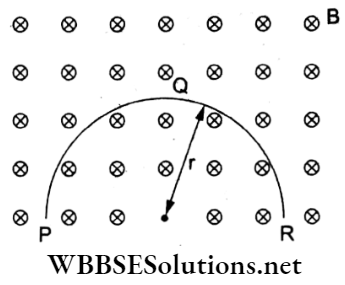
- Zero
- \(\frac{1}{2}\)With P at higher potential
- πBr2v with P at a higher potential
- 2Bvr with R at a higher potential
Answer: 4. 2Bvr with R at a higher potential
Motional emf induced in the semicircular ring will be
B.v. (effective length)= Bv(PR)= Bv2r.
The effective length is the length joining the free ends. Thus, ε = 2Bvr.
According to the relation \(\vec{F}=q(\vec{v} \times \vec{B})\) positive charge will accumulate at R, so R will be at higher potential.
Question 13. The current I through an inductor varies with time according to the plot shown in the figure. Which one of the following is the correct representation of the variation of voltage with time in the coil?
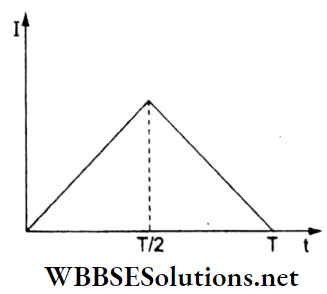
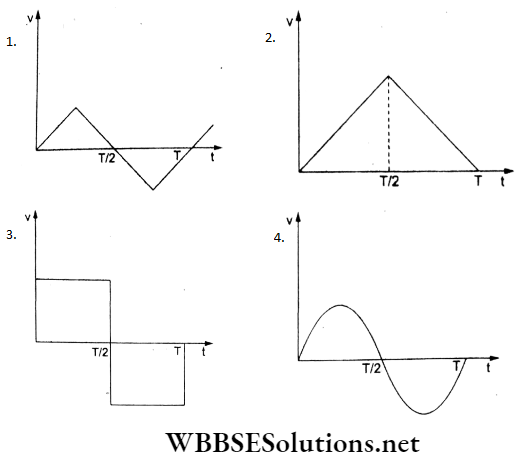
Answer: 3.
The induced voltage in an inductor is \(|V|=L\left(\frac{d I}{d t}\right), \text { where } \frac{d I}{d t}\) = slope of I~t graph. From f = 0 to \(\frac{T}{2}, \frac{d I}{d t}\) = positive and constant, whereas from \(t=\frac{T}{2} \text { to } T, \frac{d I}{d t}\) = constantbut negative.
Hence, the plot in option (3) corresponds to the true variation v~t.
Question 14. The current I flowing through a coil varies with time as shown in the figure. The variation of induced emf with time would be
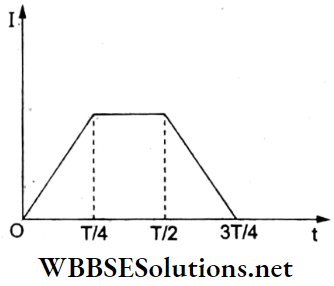
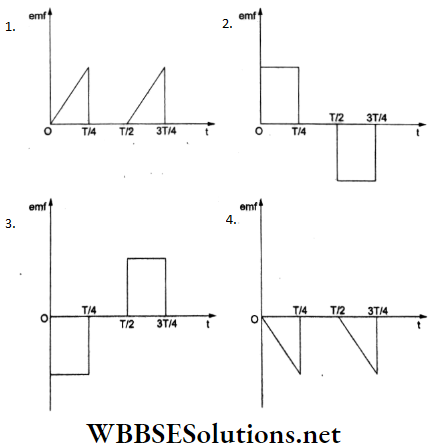
Answer: 3.
Induced emf in an inductor is \(\varepsilon=-L\left(\frac{d I}{d t}\right), \text { where } \frac{d I}{d t}\) is the slope of I-t graph. From the given figure, during the time interval 0 to \(\frac{T}{4}, \frac{d I}{d t}\) is positive and constant, so £ = negative and constant. For the interval \(\frac{T}{4} \text { to } \frac{T}{2}, \frac{d I}{d t}=0\), so emf = 0; for \(t=\frac{T}{2} \text { to } t=\frac{3 T}{4}, \frac{d I}{d t}\) negative and constant, so emf = positive and constant. This corresponds to option (3).
Question 15. A circular disc of radius 0.2m is placed in a uniform magnetic field B = \(\left(\frac{1}{\pi}\right) \mathrm{Wb} \mathrm{m}^{-2}\) in such a way that its axis makes an angle of 60° with \(\vec{B}\). The magnetic flux linked with the disc is
- 0.02 Wb
- 0.01 Wb
- 0.06 Wb
- 0.08 Wb
Answer: 1. 0.02 Wb
Magnetic flux <j) is a scalar quantity and is given by the dot product of \(\vec{B}\) and \(\vec{A}\) (area vector).
⇒ Thus, \(\phi=\vec{B} \cdot \vec{A}=B A \cos \theta\).
where θ = angle between \(\vec{B}\) and the outward normal to the area vector.
∴ \(\phi=\left(\frac{1}{\pi} W_{b ~ m^{-2}}\right)\left(\pi \times 0.04 \mathrm{~m}^2\right) \cos 60^{\circ}=0.02\).
Question 16. The magnetic flux linked with a coil of resistance R changes by an amount ΔΦ in a time Δt. The total quantity of electric charge q that flows through the coil during the time At is given by
- \(q=\frac{\Delta \phi}{\Delta t}\)
- \(q=R \frac{\Delta \phi}{\Delta t}\)
- \(q=\frac{1}{R} \frac{\Delta \phi}{\Delta t}\)
- \(q=\frac{\Delta \phi}{R}\)
Answer: 4. \(q=\frac{\Delta \phi}{R}\)
Induced emf = \(\varepsilon=\frac{d \phi}{d t}\)
But, \(I=\frac{d q}{d t}=\frac{\varepsilon}{R}=\frac{1}{R}\left(\frac{d \phi}{d t}\right)\)
⇒ \(d q=\frac{1}{R} d \phi\)
∴ Total charge = q = \(\int d q=\frac{1}{R} \int_{\phi_1}^{\phi_2} d \phi=\frac{\phi_2-\phi_1}{R}=\frac{\Delta \phi}{R}\)
Question 17. A conductor of length 0.4 m is moving uniformly with a speed of 7 m s-1 perpendicular to a uniform magnetic field of intensity 0.9 Wb m-2. The induced emf across the conductor is
- 1.26 V
- 5.04 V
- 2.52 V
- 25.2 V
Answer: 3. 2.52 V
Motional emf = ε = Blv.
Given, B = 0.9 T, l = 0.4 m and v = 7 m s-1.
∴ ε = (0.9 T)(0.4 m)(7 ms-1 ) = 2.52 V
Question 18. A rectangular coil of 20 turns and an area of cross-section 25 cm2 has a resistance of 100 Ω. If a magnetic field that is perpendicular to the plane of the coil changes at a constant rate of 1000 T s-1, the current in the coil is
- 1 A
- 5 A
- 0.5 A
- 50 A
Answer: 3.
Induced emf is
⇒ \(|\mathcal{E}|=\frac{d \phi}{d t}=N A \frac{d B}{d t}=(20)\left(25 \times 10^{-4} \mathrm{~m}^2\right)\left(10^3 \mathrm{~T} \mathrm{~s}^{-1}\right)=50 \mathrm{~V}\)
current through the coil,
∴ \(I=\frac{\varepsilon}{R}=\frac{50 \mathrm{~V}}{100 \Omega}=0.5 \mathrm{~A}\).
Question 19. A uniform magnetic field of 2 x 10-2 T is directed into the plane of a coil of area 100 cm2 having 50 turns. The average emf induced in the coil is 0.1 V when it is removed from the field in t seconds. The value of t is
- 10 s
- 1 s
- 0.01 s
- 0.1 s
Answer: 4. 0.1 s
Average emf induced is
⇒ \(\varepsilon=\frac{\Delta \phi}{\Delta t}\)
Hence, ΔΦ= NAB-0 = NAB, Δt = t, and 8 = 0,1 V.
⇒ \(0.1 \mathrm{~V}=\frac{50\left(100 \times 10^{-4} \mathrm{~m}^2\right)\left(2 \times 10^{-2} \mathrm{~T}\right)}{t}\).
∴ t = 0.1 s.
Question 20. In the circuit shown in the figure, what will happen if the contact is broken?
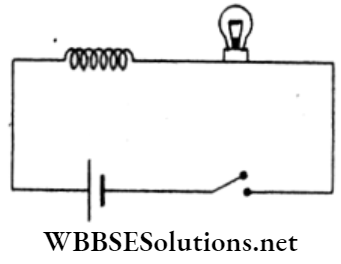
- The bulb will become suddenly bright.
- The bulb will become suddenly dim.
- The bulb will fuse.
- None of these will happen
Answer: 1. The bulb will become suddenly bright.
In the steady state, the glow in the bulb stays constant. As the contact is broken, there is a sudden change in flux, so back emf \(\frac{\Delta \phi}{\Delta t}\) becomes large. This will make the bulb suddenly very bright.
Question 21. In a region of uniform magnetic field B = 10-2 T, a circular coil of radius 30 cm and resistance π2 Q is rotated about an axis that is perpendicular to the direction of B and which forms a diameter of the coil. If the coil rotates at 200rpm, the amplitude of the alternating current induced in the coil is
- 4π2 mA
- 6 mA
- 30 mA
- 200 mA
Answer: 2. 6 mA
Let at any instant the normal to circular coil make an angle 0 with \(\vec{B}\), so the instantaneous magnetic flux is
⇒ \(\phi=\vec{B} \cdot \vec{A}=B A \cos \theta\)
Induced emf is
⇒ \(\mathcal{E}=-\frac{d \phi}{d t}=B A\left(\frac{d \theta}{d t}\right) \sin \theta\)
ε = BAωsin ωt= ε0 sin ωt,
where ε0 = peak voltage.
the peak value of induced current is
⇒ \(I_0=\frac{\varepsilon_0}{R}=\frac{B A \omega}{R}\)
∴ \(\frac{\left(10^{-2} \mathrm{~T}\right)\left(\pi \times 900 \times 10^{-4} \mathrm{~m}^2\right)(200 \times 2 \pi)}{\left(\pi^2 \Omega\right)(60 \mathrm{~s})}=6 \mathrm{~mA}\).
image
Question 22. The current in an inductor with L = 40 mH is increased uniformly from 1 A to 11 A in 4 ms. The emf induced in the inductor is
- 4 V
- 0.4 V
- 100 V
- 440 V
Answer: 3. 100 V
Given, L = 40 mH = 40 x 10-3 H, Δl= 10 A and Δt= 4 ms = 4 x 10-3 s.
The average emf induced in the inductor is
∴ \(|\mathcal{E}|=L \frac{\Delta I}{\Delta t}=\frac{\left(40 \times 10^{-3} \mathrm{H}\right)(10 \mathrm{~A})}{\left(4 \times 10^{-3} \mathrm{~s}\right)}=100 \mathrm{~V}\).
Question 23. If the number of turns per unit length of a solenoid is doubled then the self-inductance of the solenoid will
- Be halved
- Be doubled
- Remain unchanged
- Be quadrupled
Answer: 4. Be quadrupled
Self-inductance of a solenoid is
⇒ \(L=\frac{\mu_0 N^2 A}{l}=\mu_0\left(\frac{N}{l}\right)^2 A l=\mu_0 n^2 A l\)
Where \(\frac{N}{l}\) = n = number of turns per unit length.
Thus, L ∝ n2.
∴ L’= k(2n)2 = Akn2 = 4L.
Question 24. What is the self-inductance of a coil that induces 5 V when the current changes from 3.5 A to 2.5 A in one millisecond?
- 500 H.
- 5 mH
- 50H
- 5H
Answer: 2. 5 mH
\(\varepsilon=L \frac{\Delta I}{\Delta t}\)Hence, self-inductance is
∴ \(L=\frac{\varepsilon}{\left(\frac{\Delta I}{\Delta t}\right)}=\frac{5 \mathrm{~V}}{\frac{(3.5-2.5) \mathrm{A}}{10^{-3} \mathrm{~s}}}=5 \times 10^{-3} \mathrm{H}=5 \mathrm{mH}\).
Question 25. A long solenoid has 500 turns. When a current of 2 A is passed through it, the resulting magnetic flux linked with each turn of the solenoid is 4 x 10-3 Wb. The self-inductance of the solenoid is
- 2H
- 1H
- 2.5H
- 4H
Answer: 2. 1H
Given, N= 500, 1= 2 A, and Φ0 = 4 x 10-3 Wb per turn.
Now, Φ -= NΦ0 = LI.
Hence, self-inductance is
⇒ \(L=\frac{N \phi_0}{I}=\frac{(500)\left(4 \times 10^{-3} \mathrm{~Wb}\right)}{(2 \mathrm{~A})}=1 \mathrm{H}\).
Question 26. A varying current in a coil changes from 10 A to zero in 0.5 s. If the average emf induced in the coil is 220 V, the self-inductance of the coil is
- 5H
- 6H .
- 11H
- 12H
Answer: 3. 11H
Given, Δl =10 A, Δt = 0.5 s and ε = 220 V.
∴ \(L=\frac{N \phi_0}{I}=\frac{(500)\left(4 \times 10^{-3} \mathrm{~Wb}\right)}{(2 \mathrm{~A})}=1 \mathrm{H}\).
Question 27. A 100-mH coil carries a steady current of 1 A. The energy stored in its magnetic field is
- 0.5 J
- 0.05 J
- 1 J
- 0.1 J
Answer: 2. 0.05 J
Magnetic energy stored in an inductor is
∴ \(U=\frac{1}{2} L I^2=\frac{1}{2}\left(100 \times 10^{-3} \mathrm{H}\right)(1 \mathrm{~A})^2=0.05 \mathrm{~J}\).
Question 28. A wire loop is rotated in a magnetic field. The frequency of change of direction of the induced emf is
- Once per revolution
- Twice per revolution
- Four times per revolution
- Six times per revolution
Answer: 2. Twice per revolution
In a coil rotating in a magnetic field, an alternating emf ε = ε0 sinωt is induced which is shown in the adjoining diagram. In one cycle (t = 0 to t = T), there are two instants (at P and Q) when emf changes its direction.
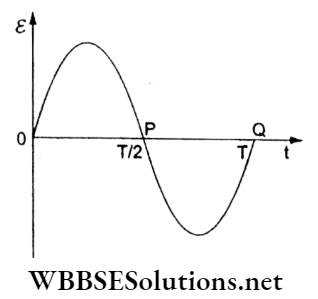
Question 29. A coil of wire of a certain radius has 100 turns and a self-inductance of 15 mH. The self-inductance of a similar second coil of 500 turns will be
- 75 mH
- 375 mH
- 15 mH
- None of these
Answer: 2. 375 mH
Self-inductance of a solenoid is
⇒ \(L=\frac{\mu_0 N^2 A}{l}=15 \mathrm{mH}=\frac{\mu_0 A}{l}(100)^2\)
If the total number of turns N is increased from 100 to 500 then
∴ \(L^{\prime}=\frac{\mu_0 A}{l}(500)^2=25 L=25(15 \mathrm{mH})=375 \mathrm{mH}\).
Question 30. The self-inductance of a coil having 400 turns is 10 mH. The magnetic flux through the cross-section of the coil corresponding to current 2mA is
- 2 x 10-5 Wb
- 2 x 10-3 Wb
- 3 x 10-5 Wb
- 8 x 10-3 Wb
Answer: 4. 8 x 10-3 Wb
Magnetic flux Φ linked with a coil is Φ = NLI.
Substituting the values,
Φ = (400)(10 x 10-3 H)(2 x 10-3 A) = 8 x 10-3 Wb.
Question 31. Two solenoids of equal number of turns have their lengths and radii in the same ratio 1: 2. The ratio of their self-inductances will be
- 1:2
- 2:1
- 1:1
- 1:4
Answer: 1. 1:2
Self-inductance of a solenoid is
⇒ \(L=\frac{\mu_0 N^2 A}{l}\)
For the same value of N,
∴ \(\frac{L_1}{L_2}=\left(\frac{A_1}{A_2}\right)\left(\frac{l_2}{l_1}\right)=\left(\frac{r_1}{r_2}\right)^2\left(\frac{l_2}{l_1}\right)=\left(\frac{1}{2}\right)^2\left(\frac{2}{1}\right)=\frac{1}{2}\).
Question 32. When magnetic flux changes by 2 x 10-2 Wb and current changes by 0.01 A, the coefficient of mutual inductance is
- 4H
- 2H
- 3H
- 8H
Answer: 2. 2H
We know that Φ2 = MI1
⇒ ΔΦ2 = MΔI1
⇒ \(M=\frac{\Delta \phi_2}{\Delta I_1}=\frac{2 \times 10^{-2} \mathrm{~Wb}}{1 \times 10^{-2} \mathrm{~A}}=2 \mathrm{H}\).
Question 33. Mutual inductance M between two concentric coils of radii 1 m and 2 m is
- \(\frac{\mu_0 \pi}{2}\)
- \(\frac{\mu_0 \pi}{8}\)
- \(\frac{\mu_0 \pi}{4}\)
- \(\frac{\mu_0 \pi}{10}\)
Answer: 3. \(\frac{\mu_0 \pi}{4}\)
Let I1 be the current through the outer ring.
The magnetic field produced at the center is
⇒ \(B_1=\frac{\mu_0 I_1}{2 R}\)
Magnetic flux linked with the inner coil is
Φ2 = B1A2 = B1πr2.
∵ Φ2 = MI1
∴ \(M=\frac{\phi_2}{I_1}=\frac{B_1 \pi r^2}{I_1}\)
⇒ \(\left(\frac{\mu_0 I_1}{2 R}\right)\left(\frac{\pi r^2}{I_1}\right)=\frac{\mu_0 \pi}{2}\left(\frac{r^2}{R}\right)\)
∴ \(\frac{\mu_0 \pi}{2}\left(\frac{1 \mathrm{~m}}{2 \mathrm{~m}}\right)=\frac{\mu_0 \pi}{4}\).
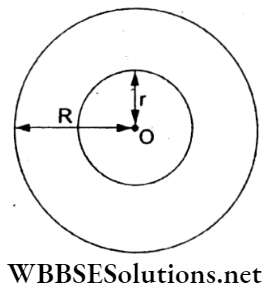
Question 34. Two coils of self-inductances 2 mH and 8 mH are placed so close together that the effective flux in one coil is completely linked with the other. The mutual inductance between these coils is
- 10 mH
- 6 mH
- 4 mH
- 16 mH
Answer: 3. 4 mH
For maximum flux linkage between two coils, M = √L1L2, where M = mutual inductance between the two coils, and L1, and L2 are the self-inductances of the two coils.
Given, L1 = 2 mH, = 8 mH.
Hence, M = √L1,L2 = √(2 mHK8 mH) = 4 mH.
Question 35. If the rotational speed of a dynamo armature is doubled then the induced emf will
- Become half
- Become two times
- Become four times
- Remain unchanged
Answer: 2. Become two times
The induced voltage in a dynamo is
V= V0 sin ωt = ABNωsin ωt,
where CD = angular frequency and V0 is the voltage amplitude.
When ω is doubled, the induced voltage is also doubled.
Question 36. A conducting ring of radius 1 meter is placed in a uniform magnetic field B of 0.01 T, oscillating with a frequency of 100 Hz with its plane perpendicular to B. What will be the induced electric field?
- π V m-1
- 10 V m-1
- 62 V m-1
- 2 V m-1
Answer: 4. 2 V m-1
Induced emf is
⇒ \(|\mathcal{E}|=\frac{d \phi}{d t}=\frac{d}{d t}(B A)=\pi r^2 \frac{d B}{d t}\) →(1)
If E is the electric field induced in the ring then
⇒ \(\varepsilon=\int E \cdot d l=E \cdot 2 \pi r\) →(2)
From (1) and (2),
⇒ \(E \cdot 2 \pi r=\pi r^2\left(\frac{2 B}{T / 2}\right)\),
since the magnetic field changes from +B to -B in time T/2
∴ \(E=\frac{2 r B}{T}=2 r B f=2(1.0 \mathrm{~m})(0.01 \mathrm{~T})\left(100 \mathrm{~s}^{-1}\right)=2 \mathrm{~V} \mathrm{~m}^{-1}\).
Question 37. A circular coil of cross-sectional area 4 cm2 has 10 turns. It is placed at the center of a long solenoid that has 15 turns per cm and a cross-section of 10 cm2, as shown in the Question figure. The axis of the coil coincides with the axis of the solenoid. What is their mutual inductance?
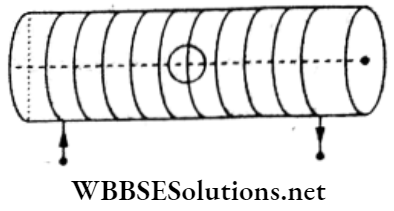
- 7.54 μH
- 9.54 μH
- 8.54 μH
- 10.54 μH
Answer: 1. 7.54 μH
The magnetic field well inside the solenoid is
B = μ0nI1
The magnetic flux linked with the coil at the center is
Φ2 = BAN = (μ0nI1)AN.
If M = mutual inductance,
Φ2 =MI1
⇒ \(M=\frac{\phi_2}{I_1}=\frac{\left(\mu_0 n I_1\right) A N}{I_1}=\mu_0 n A N\)
Given, N =10, A = 4 cm2 = 4 x 10-4 m2 and n = 1500 m-1.
M = (4π x 10-7H m-1)(1500 m-1)(4 x10-4 m2)(10)
= 7.54 x 10-6 H = 7.54 μH.
Question 38. The mutual inductance of two coils can be increased by
- Decreasing the number of turns in the coils
- Increasing the number of turns in the coils
- Winding the coils on a wooden core
- None of these
Answer: 2. Increasing the number of turns in the coils
Mutual inductance between two coils is
⇒ \(M=\frac{\mu_0 N_1 N_2 A}{l}\)
M can be increased by increasing N1 and N2 which are the number of turns in the coil.
Question 39. A long solenoid of diameter 0.1 m has 2 x 104 turns per meter. At the center of the solenoid, a coil of 100 turns and a radius of 1.0 cm is placed with its axis coinciding with the axis of the solenoid. The current in the solenoid reduces at a constant rate from 4 A to 0 A in 0.05 s. If the resistance of the coil is 10π2 Ω, the total charge flowing through the coil during this time is
- 32π μC
- 16 μC
- 32 μC
- 16tc μC
Answer: 3. 32 μC
Given, the radius of the solenoid = r1 = 0.05 m and the number of turns per meter = 2 x 104 m-1.
For the small coil, N =100, r2 = 1 x 10-2 m, resistance, R=10π2 Ω.
The magnetic field through the small coil is
B = μ0nl.
Magnetic flux linked with the coil is
Φ = NBA= Nπr22 μ0nl.
The induced current through the coil is
⇒ \(\frac{d Q}{d t}=I=\frac{|\mathcal{Q}|}{R}=\frac{1}{R} \frac{d \phi}{d t} \Rightarrow Q=\frac{1}{R} \int_0^\phi d \phi=\frac{\phi}{R}\)
∴ \(Q=\frac{100\left(\pi \times 10^{-4} \mathrm{~m}^2\right)\left(4 \pi \times 10^{-7} \mathrm{H} \mathrm{m}^{-1}\right)\left(2 \times 10^4 \mathrm{~m}^{-1}\right)(4 \mathrm{~A})}{10 \pi^2 \Omega}\).
= 32 x l0-6C = 32 μC.
Question 40. A rectangular coil of size 12 cm x 10 cm having 50 turns is suspended vertically in a uniform magnetic field of strength 0.2 Wb m-2. The coil carries a steady current of 2 A. If the plane of the coil is inclined at an angle of 30° with the direction of the magnetic field, the torque required to keep the coil in stable equilibrium will be
- 0.24 N m
- 0.15N m
- 0.20 N m
- 0.12N m
Answer: 3. 0.20 N m
The magnetic dipole moment of the rectangular coil is m = NLA.
It is directed along the perpendicular to the plane of the coil.
⇒ Torque = \(\vec{\tau}=\vec{m} \times \vec{B} \Rightarrow|\vec{\tau}|=N I A B \sin \theta\)
Given, N = 50, I = 2 A, A =120 x 10-4 m2, B = 0.2 T, and θ= angle between the normal to the plane of the coil and the field
= 90°- 30°= 60°.
Substituting the values, the required torque tomaintainequilibriumis
∴ \(\tau=(50)(2 \mathrm{~A})\left(120 \times 10^{-4} \mathrm{~m}^2\right)(0.2 \mathrm{~T})\left(\frac{\sqrt{3}}{2}\right)=0.20 \mathrm{~N} \mathrm{~m}\).
Question 41. In an inductor of self-inductance L = 2 mH, current changes with time according to the relation I = t2e-t. At what time the induced emf is zero?
- 4 s
- Is
- 3s
- 2s
Answer: 4. 2s
Induced emf in an inductor is
⇒ \(\varepsilon=L \frac{d I}{d t}=L \frac{d}{d t}\left(t^2 e^{-t}\right)=L\left(2 t e^{-t}-t^2 e^{-t}\right)=L e^{-t}\left(2 t-t^2\right)\).
For induced emf to be zero,
t2 – 2t = 0 ⇒ t = 2s.
Question 42. Two coils have a mutual inductance of 5 x 10-3 H. The current changes in the first coil according to the equation I = I0 sinωt, where I0 =10 A and ω = 100π rad s-1. The maximum value of the emf induced in the second coil is
- 27π V
- 5π V
- 4π V
- π V
Answer: 2. 5π V
In mutual induction, induced emf in coil 2 (=ε2) is equal to \(M\left(\frac{d I_1}{d t}\right)\), where I1 is the currentin coil 1.
⇒ \(\varepsilon_2=M \frac{d I_1}{d t}=M \frac{d}{d t}\left(I_0 \sin \omega t\right)=M I_0 \omega \cos \omega t\).
Hence, the peak value of the induced emf in coil 2 is
∴ \(\varepsilon_{20}=M I_0 \omega=\left(5 \times 10^{-3} \mathrm{H}\right)(10 \mathrm{~A})\left(100 \pi \mathrm{s}^{-1}\right)=5 \pi \mathrm{V}\).
Question 43. A rectangular, a square, a circular, and an elliptical loop, all in the xy-plane are pulled out of a uniform magnetic field with a constant velocity \(\vec{v}=v \hat{i}\). The magnetic field is directed along the negative z-axis. The induced emf during the passage of these loops, out of the field region, will not remain constant for
- The rectangular, circular, and elliptical loops
- The circular and elliptical loops
- The elliptical loop only
- Any of the four loops
Answer: 2. The circular and elliptical loops
For the rectangular plate, the area pulled out per second is constant, so the induced emf during its passage out of the field will remain constant with time.
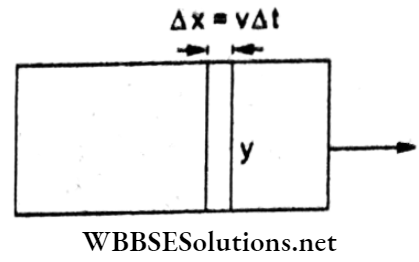
For the circular and elliptical loops, the length of the chord changes, so the area pulled out per second varies, and hence induced emf will vary with time.
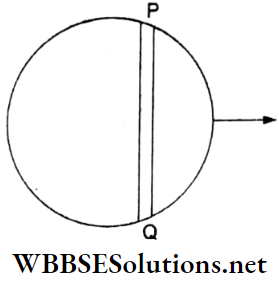
Question 44. A conducting ring of radius r with N turns lies in a horizontal plane. A uniform magnetic field B exists in the vertical direction. If the ring spins about its vertical axis with an angular velocity ω, the emf induced in the ring will be
- πr2Bω
- \(\frac{1}{2} \pi r^2 B \omega\)
- πr2B
- Zero
Answer: 4. Zero
When the conducting ring spins about the vertical axis, the magnetic flux <}> linked with the ring remains constant, i.e., Φ = NAB, so the induced emf,
∴ \(|\mathcal{E}|=\frac{d \phi}{d t}=0\)
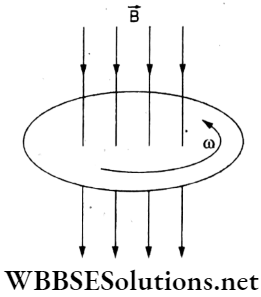
Question 45. In the given circuit, switch X is joined to Y for a long time, and then X is joined to Z. The total heat produced in R2 is
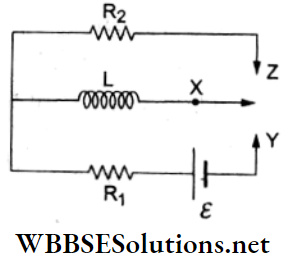
- \(\frac{1}{2} \frac{L E^2}{R_2^2}\)
- \(\frac{1}{2} \frac{L \mathcal{E}^2}{R_1^2}\)
- \(\frac{1}{2} \frac{L \mathcal{E}^2}{2 R_1 R_2}\)
- \(\frac{1}{2} \frac{L \mathcal{E}^2 R_2}{R_1^3}\)
Answer: 2. \(\frac{1}{2} \frac{L \mathcal{E}^2}{R_1^2}\)
When the switch X is joined to Y, the steady current through the closed circuit is I = \(I=\frac{\varepsilon}{R_1}\) and the magnetic energy ’stored in the inductor is
⇒ \(U_B=\frac{1}{2} L I^2=\frac{1}{2} \frac{L \mathcal{E}^2}{R_1^2}\)
When X and Z are joined, this magnetic energy UB appears as heat energy in R2.
Question 46. A small coil of radius r is placed at the center of a large coil of radius R, where R » r. The two coils are coplanar. The mutual inductance between the coils is proportional to
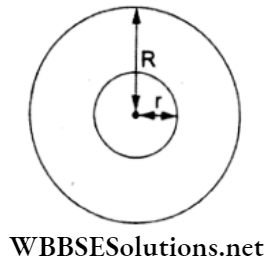
- \(\frac{r}{R}\)
- \(\frac{r^2}{R}\)
- \(\frac{r^2}{R^2}\)
- \(\frac{r}{R^2}\)
Answer: 2. \(\frac{r^2}{R}\)
Let the current in the outer ring be I.
∴ magnetic field at the centre = \(B=\frac{\mu_0 I}{2 R}\)
Magnetic flux linked with the coil at the center is
⇒ \(\phi=B A=\frac{\mu_0 I}{2 R} \cdot \pi r^2\)
∵ Φ = MI.
⇒ \(M=\frac{\phi}{I}=\frac{\mu_0 I \pi r^2}{2 R I}=\frac{\mu_0 \pi}{2} \frac{r^2}{R}=k\left(\frac{r^2}{R}\right)\).
∴ Hence, \(M \propto \frac{r^2}{R}\).
Question 47. A capacitor of capacitance C is initially given a charge Q and then connected to an inductor of inductance L by closing tire switch S. The peak current flowing through the circuit at any later time will be
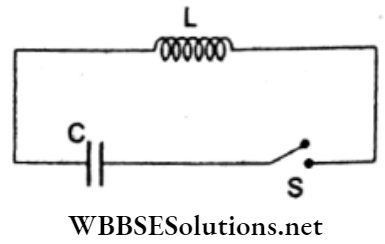
- \(\frac{Q}{2 \sqrt{L C}}\)
- \(\frac{Q}{\sqrt{L C}}\)
- \(\frac{2 Q}{\sqrt{L C}}\)
- \(\frac{2}{\pi} \frac{Q}{\sqrt{L C}}\)
Answer: 2. \(\frac{Q}{\sqrt{L C}}\)
Current through the inductor will be maximum when the total energy associated with the capacitor is transferred to the inductor.
⇒ Thus, \(\frac{Q^2}{2 C}=\frac{1}{2} L I_0^2\)
∴ Peak current = \(I_0=\frac{Q}{\sqrt{L C}}\)
Question 48. When a charged capacitor is connected across a pure inductor, electrical oscillations are executed, and the charge Q on the capacitor and the current I through the inductor vary with time sinusoidally. The phase difference between Q and I is
- π
- \(\frac{\pi}{4}\)
- \(\frac{\pi}{2}\)
- Zero
Answer: 3. \(\frac{\pi}{2}\)
During LC oscillation,
⇒ \(\frac{Q^2}{2 C}+\frac{1}{2} L I^2=\text { constant }\)
Differentiating the above equation twice w.r.t. time, we get
⇒ \(\frac{d^2 Q}{d t^2}=-\frac{1}{\sqrt{L C}} Q\), Which gives the charge Q as a function of time.
Here, Q = Q0 cos cof and I = \(I=\frac{d Q}{d t}=-Q_0 \omega \sin \omega t=Q_0 \omega \cos \left(\omega t+\frac{\pi}{2}\right)\)
∴ Thus, the phase difference between Q and I is \(\frac{\pi}{2}\).
Question 49. A current-carrying conducting flat coil has a magnetic moment \(\vec{m}\). It is placed in a magnetic field \(\vec{B}\) such that \(\vec{m}\) and \(\vec{B}\) antiparallel. The coil is
- Not in equilibrium
- In neutral equilibrium
- In stable equilibrium
- In unstable equilibrium
Answer: 4. In unstable equilibrium
The potential energy of a magnetic: dipole of the moment \(\vec{m}\) placed in a magnetic field\(\vec{B}\) is
⇒ \(U=-\vec{B} \cdot \vec{m}=-m B \cos \theta\)
⇒ When \(\vec{m}\) and \(\vec{B}\) are anti-parallel,
0=180°, so U = +mB.
The dipole is in stable equilibrium when PE is minimum (= -mB at θ= 0°) and in unstable equilibrium when PE is maximum (- +mB at θ= 180°).
Hence, the coilisin unstable equilibrium.
Question 50. In the given figure, the conducting ring B is free to move along the horizontal axis of an electromagnet A. The current through A can be altered.
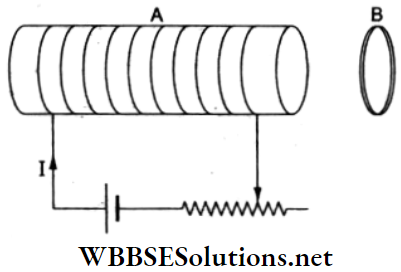
- If I increase, A will repel B
- If I increase, A will attract B
- If I decreases, A will repel B
- If I increase, A will undergo a to-and-fro motion
Answer: 1. If I increases, A will repel B
When the current through coil A increases, the magnetic flux linked with the conducting ring also increases and emf is induced in B. According to Lenz’s law, since the cause of induced emf in the die ring is increasing magnetic flux, the ring will be repelled by A so as to decrease the linked magnetic flux.
Question 51. A ring of radius r and resistance R falls vertically. It is always in contact with two vertical rails which are joined at the top. The rails are without friction and have negligible resistance. A uniform magnetic field of magnitude B exists perpendicular to the plane of the ring and the rails. When the speed of the ring is v, the current in section PQ will be
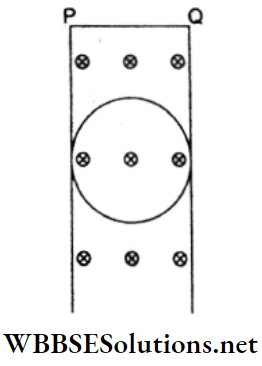
- \(\frac{2 B r v}{R}\)
- \(\frac{4 B r v}{R}\)
- \(\frac{8 B r v}{R}\)
- Zero
Answer: 3. \(\frac{8 B r v}{R}\)
Emf induced across the diameter of the ring is £- B(2r)v and each half of the ring has resistance \(\frac{R}{2}\). The circuit can be redrawn as shown in the adjoining figure.
From loop rule,
⇒ \(\frac{I}{2}\left(\frac{R}{2}\right)-\varepsilon=0\)
∴ \(I=\frac{4 \varepsilon}{R}=\frac{4(2 B v r)}{R}=\frac{8 B r v}{R}\)
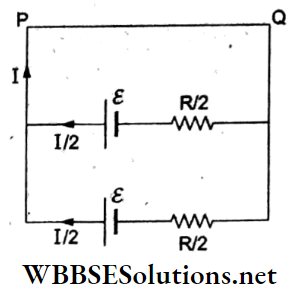
Question 52. The network shown in the figure is part of a complete circuit. At an instant when the current I is 5 A and is decreasing at a rate of 103 A s-1 then VA-VB is
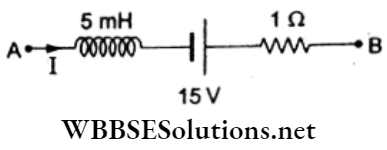
- 15V
- 20V
- -15 V
- -5V
Answer: 3. -15 V
From the given figure,
⇒ \(V_{\mathrm{A}}-V_{\mathrm{B}}=\left(V_{\mathrm{A}}-V_{\mathrm{a}}\right)+\left(V_{\mathrm{a}}-V_{\mathrm{b}}\right)+\left(V_{\mathrm{b}}-V_{\mathrm{B}}\right)\)
⇒ \(L\left(\frac{d I}{d t}\right)-\varepsilon+R I\)
⇒ \(\left(5 \times 10^{-3} \mathrm{H}\right)\left(-10^3 \mathrm{~A} \mathrm{~s}^{-1}\right)-15 \mathrm{~V}+(5 \mathrm{~A})(1 \Omega)\)
∴ \(-5 V-15 V+5 V=-15 V\).

Question 53. The adjoining figure shows a conducting wire PQ sliding on two parallel conducting rails separated at a distance d. A uniform magnetic field B exists in the region directed perpendicularly into the plane of the paper. The force required to keep the wire sliding at a constant velocity v will
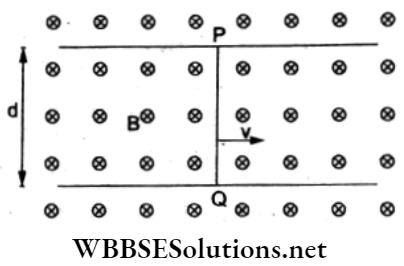
- Depends on v alone
- Depend on \(\vec{B}\) alone
- Depend on both v and \(\vec{B}\)
- Be zero
Answer: 4. Be zero
Magnetic force on a current-carrying wire moving in a magnetic field is given by
⇒ \(\vec{F}=I(\vec{l} \times \vec{B})\),
where I is the current through the conductor. In the given case both the ends of the rails are open, so no current flows through, and hence force on PQ is zero.
Question 54. The adjoining figure shows a circuit that contains three. identical resistors with resistance R = 9.0 Ω each, two identical inductors L = 2 mH each, a capacitor of 10 μF, and a battery with emf ε = 18 V. The current I through the battery just after the switch S is closed is
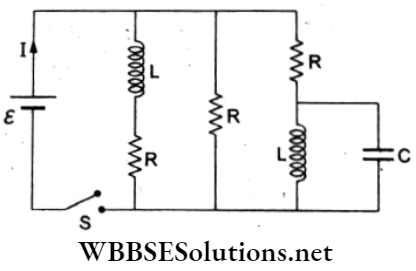
- 0.4 A
- 4.0 A
- 0 A
- 2 mA
Answer: 2. 4.0 A
When the switch is closed, the instantaneous current distribution through various branches is shown in the figure. At t= 0, the inductor offers high resistance so no current throughbranch AB. Current is equally divided at C in two branches as the capacitor acts as a conductor at t = 0.
⇒ Hence, net resistance = \(=\frac{9}{2} \Omega\)(in parallel combination).
Current through the battery is
⇒ \(I=\frac{\varepsilon}{R / 2}=\frac{18}{9 / 2} \mathrm{~A}=4 \mathrm{~A}\)
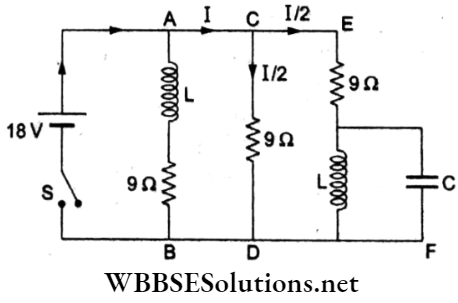
Question 55. In which of the following devices the eddy current effect is not used?
- Induction furnace
- Electromagnet
- Magnetic braking in train
- Electric heater
Answer: 4. Electric heater
Eddy currents are loops of electrical current induced within conductors by a time-varying magnetic field within the conductor following Faraday’slaw of EMI. The electric heater does not involve eddy current but it converts electrical energy into Joule heat.
Question 56. An 800-turn coil of effective area 0.05 m2 is kept perpendicular to a magnetic field of 5 x 10-5 T. When the plane of the coil is rotated by 90° about any of its coplanar axes in 0.1 s, the emf induced in the coil will be
- 2 V
- 0.2 V
- 2 x 10-3V
- 0.02 V
Answer: 4. 0.02 V
Magnetic flux, \(\phi=N \vec{A} \cdot \vec{B}=N A B \cos \theta\), where 0 is the angle between \(\vec{B}\) and the normal to the area of the coil. Initially 0= 0° and finally 0= 90° during the time duration Af= 0.1 s.
According to Faraday’s law, induced emf is
⇒ \(\varepsilon=-\frac{\Delta \phi}{\Delta t}=-\frac{\phi_{\mathrm{f}}-\phi_{\mathrm{i}}}{\Delta t}=-\frac{N B A \cos 90^{\circ}-N B A}{0.1 \mathrm{~s}}\)
∴ \(\frac{N B A}{0.1 \mathrm{~s}}=\frac{(800)\left(5 \times 10^{-5} \mathrm{~T}\right)\left(0.05 \mathrm{~m}^2\right)}{0.1 \mathrm{~s}}=0.02 \mathrm{~V}\).
Question 57. If maximum energy is stored in the capacitor at time t = 0 then the time at which current in the circuit during LC oscillation will be maximum is
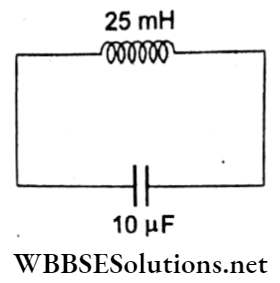
- \(\frac{\pi}{2} \mathrm{~ms}\)
- 3 ms
- \(\frac{\pi}{4} \mathrm{~ms}\)
- ms
Answer: 3. \(\frac{\pi}{4} \mathrm{~ms}\)
The variation in magnetic energy UB (associated with L) and electrical energy UE (associated with C) with time is shown in the diagram. When electrical energy with a capacitor is maximum, magnetic energy with L is zero. After one fourth of oscillation \(\left(t=\frac{T}{4}\right), u_B\), is maximum (with current maximum). But the time period is T = 2piLC
⇒ Hence, required time = \(t=\frac{T}{4}=\frac{\pi}{2} \sqrt{L C}=\frac{\pi}{2} \sqrt{\left(25 \times 10^{-3} \mathrm{H}\right)\left(10 \times 10^{-6} \mathrm{~F}\right)}\)
∴ \(\frac{\pi}{2} \times 5 \times 10^{-4} \mathrm{~s}=\frac{\pi}{4} \mathrm{~ms}\)
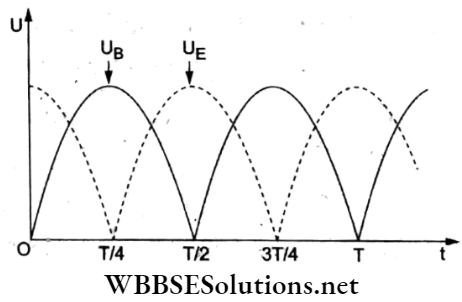
Question 58. Let f1 be the frequency of LC oscillation. If a resistance R is also added to it in series, the frequency becomes f2. The ratio \(\frac{f_2}{f_1}\) will be
- \(\sqrt{1+\frac{R^2 C}{4 L}}\)
- \(\sqrt{1-\frac{R^2 C}{4 L}}\)
- \(\sqrt{1+\frac{R^2 C}{L}}\)
- \(\sqrt{1-\frac{R^2 C}{L}}\)
Answer: 2. \(\sqrt{1-\frac{R^2 C}{4 L}}\)
In an LC circuit (in the absence of resistance), the angular frequency is \(\omega_1=2 \pi f_1=\frac{1}{\sqrt{L C}}\)
In the presence of resistance Rin the circuit
⇒ \(\omega_2^2=\omega_1^2-\left(\frac{R}{2 L}\right)^2\)
⇒ \(\omega_1^2-\omega_2^2=\frac{R^2}{4 L^2}\)
⇒ \(\omega_1^2\left(1-\frac{\omega_2^2}{\omega_1^2}\right)=\frac{R^2}{4 L^2}\)
⇒ \(\frac{1}{L C}\left(1-\frac{\omega_2^2}{\omega_1^2}\right)=\frac{R^2}{4 L^2}\)
⇒ \(\frac{\omega_2^2}{\omega_1^2}=1-\frac{R^2}{4 L^2} \times L C=1-\frac{R^2 C}{4 L}\)
∴ \(\frac{f_2}{f_1}=\sqrt{1-\frac{R^2 C}{4 L}}\)
Question 59. A solid metal cube of length 2cm is moving in the positive direction at a constant speed of 6 s-1. There is a uniform magnetic field of 0.1 T in the positive z-direction. The potential difference between the two faces of the cube perpendicular to the x-axis is
- 2 mV
- 12 mV
- 6 mV
- l mV
Answer: 2. 12 mV
Motional emf (£ =Bfo) induced in each of the four edges of the cube parallel to the r-axis are parallel Hence, PD between the two faces of the cube perpendicular to the r-axis will be
⇒ \(\mathcal{E}=B l v=(0.1 \mathrm{~T})\left(2 \times 10^{-2} \mathrm{~m}\right)\left(6 \mathrm{~m} \mathrm{~s}^{-1}\right)\)
∴ \(12 \times 10^{-3} \mathrm{~V}=12 \mathrm{mV}\)
Question 60. The self-induced emf of a coil is 25 V. When the current through this coil is changed at a uniform rate from 10 A to 25 A in 1 s, the change in the magnetic energy linked with the coil is
- 437.5 J
- 740 J
- 637.5 J
- 540 J
Answer: 1. 437.5 J
Induced emf in an inductor is
⇒ \(|\mathcal{E}|=L \frac{d I}{d t}\)
⇒ \(25 \mathrm{~V}=L \frac{(25 \mathrm{~A}-10 \mathrm{~A})}{1 \mathrm{~s}} \Rightarrow L=\frac{25}{15} \mathrm{H}=\frac{5}{3} \mathrm{H}\)
Change in magnetic energy linked with the inductor is
∴ \(\Delta U=\frac{1}{2} L\left(I_1^2-I_2^2\right)=\frac{1}{2}\left(\frac{5}{3} \mathrm{H}\right)\left(625 \mathrm{~A}^2-100 \mathrm{~A}^2\right)=437.5 \mathrm{~J}\).
Question 61. A circular conducting loop is made of a thin wire having a cross-sectional area of 3.5 x 10-2 m2 and a resistance of 10 Ω. It is placed perpendicular to a time-dependent magnetic field B(t)= (0.4 T)sin (0.5πt). The field is uniform in space. The net charge that flows through the loop during t = 0 to t =1.0 s is close to
- 6 mC
- 21 mC
- 7 mC
- 1.4 mC
Answer: 4. 1.4 mC
Induced emf = \(|\mathcal{E}|=\frac{d \phi}{d t}\)
Induced current= I = \(\frac{1}{R} \frac{d \phi}{d t}\)
⇒ Net charge = Q = \(\int I d t=\frac{1}{R} \int d \phi=\frac{1}{R}[A B]_{t=0}^{t=1 \mathrm{~s}}\)
⇒ \(\frac{A}{R} B_0\left[\sin \frac{\pi}{2} t\right]_0^1=\frac{\left(3.5 \times 10^{-2} \mathrm{~m}^2\right)(0.4 \mathrm{~T})}{(10 \Omega)}\)
∴ \(1.4 \times 10^{-3} \mathrm{C}=1.4 \mathrm{mC}\).
Question 62. The figure shows a square loop L of side 5 cm which is connected to a network of resistances. The whole 5 cm set-up is moving towards the right with a uniform velocity of 1cm s-1. At some instant, a part of L is in a uniform magnetic field of 1 T perpendicular to the plane of the loop. If the resistance of L is 1.7 Ω, the current in the loop at that instant will be close to
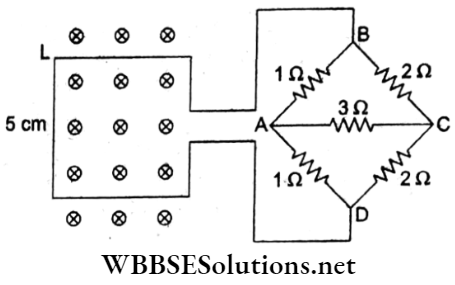
- 170 μA
- 50 μA
- 11.5 μA.
- 60 μA.
Answer: 1. 170 μA
Equivalent resistance across BD of the bridge
⇒ \(R_1=\frac{4 \Omega \times 2 \Omega}{6 \Omega}=\frac{4}{3} \Omega=1.3 \Omega\)
Resistance of loop L is = 1.7 Ω.
Total resistance=R = R1 + R2= 1.3 Ω+ 1.7 Ω= 3.0 Ω
Motional emf induced = ε = Blv
⇒ \((1.0 \mathrm{~T})\left(5 \times 10^{-2} \mathrm{~m}\right)\left(1 \times 10^{-2} \mathrm{~m} \mathrm{~s}^{-1}\right)\)
⇒ \(5 \times 10^{-4} \mathrm{~V}\).
current in the loop is
∴ \(I=\frac{\varepsilon}{R}=\frac{5 \times 10^{-4} \mathrm{~V}}{3 \Omega}=1.66 \times 10^{-4} \mathrm{~A} \approx 1.7 \times 10^{-4} \mathrm{~A}=170 \mu \mathrm{A}\).
Question 63. Two coils P and Q are separated, by some distance. When a current of 3 A flows through coil P, a magnetic flux of 10-3 Wb is linked with Q. No current is passed through Q. When no current is passed through P and a current of A is passed through Q, the flux through P is
- 3.67 x 10-4 Wb
- 6.67 x 10-3 Wb
- 3.67 x 10-3 Wb
- 6.67 x 10-4 Wb
Answer: 4. 6.67 x 10-4 Wb
Let M be the mutual inductance between the coils P and Q. Thus, magnetic flux linked with Q =M x current in P.
⇒ \(\phi_{\mathrm{Q}}=M I_{\mathrm{P}} \Rightarrow 10^{-3} \mathrm{~Wb}=M(3 \mathrm{~A})\)
⇒ \(M=\frac{10^{-3}}{3} \mathrm{H}\)
⇒ Next, \(\phi_{\mathrm{P}}=M I_{\mathrm{Q}}=\left(\frac{10^{-3}}{3} \mathrm{H}\right)(2 \mathrm{~A})=0.667 \times 10^{-3} \mathrm{~Wb}\)
∴ \(\phi_P=6.67 \times 10^{-4} \mathrm{~Wb}\).
Question 64. The circuit shown in the figure has two identical resistors with R = 5 Ω and an inductor with mH. An ideal battery of 15 V is connected to the circuit. When switch S is closed, the current through the battery after a long time will be
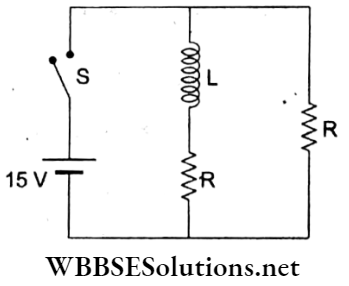
- 5.5 A
- 7.5 A
- 6 A
- 3 A
Answer: 3. 6 A
The inductor offers high resistance at t= 0 and becomes conducting after a long time. Thus, the effective resistance in the circuit is R/2 and L is ineffective when a steady state is reached. Thus,
∴ \(I=\frac{\varepsilon}{R / 2}=\frac{15 \mathrm{~V}}{\frac{5}{2} \Omega}=6 \mathrm{~A}\).
Question 65. A 10-m-long horizontal wire extends from northeast to southwest. It is falling with a speed of 50 m s-1 at a right angle to the horizontal component of the earth’s magnetic field of 0.30 x 10-4 T. The value of the induced emf in the wire is
- 15 mV
- 0.3 mV
- 2.5 mV
- 1.1 mV
Answer: 1. 15 mV
Given, the length of the wire = l =10 m; velocity = p = 50 m s-1; horizontal component of earth’s magnetic field = B = 0.30 x 10-4 T.
Since the wire falls perpendicular to the magnetic field, motional emf induced will be
∴ \(\varepsilon=B l v=\left(0.3 \times 10^{-4} \mathrm{~T}\right)(10 \mathrm{~m})\left(50 \mathrm{~m} \mathrm{~s}^{-1}\right)=15 \mathrm{mV}\).
Question 66. There are two long coaxial solenoids of the same length l. The inner and outer coils have radii r1 and r2 and the numbers of turns per unit length are n1 and n2 respectively. The ratio of mutual inductance to the self-inductance of the inner coil is
- \(\frac{n_2}{n_1} \frac{r_1}{r_2}\)
- \(\frac{n_2}{n_1} \frac{r_2^2}{\frac{n_1^2}{2}}\)
- \(\frac{n_2}{n_1}\)
- \(\frac{n_1}{n_2}\)
Answer: 3. \(\frac{n_2}{n_1}\)
Let N1 and N2 be the total numbers of turns in the inner and outer solenoids of the same length l.
Mutual conductance between them is
⇒ \(M=\mu_0 \frac{N_1 N_2 A}{l}\)
Self-inductance of the inner coil is
⇒ \(L=\mu_0 \frac{N_1^2 A}{l} \text {, where } A=\pi r_1^2\)
∴ \(\frac{M}{L}=\frac{N_2}{N_1}=\frac{n_2 l}{n_1 l}=\frac{n_2}{n_1}\)
Question 67. A coil of radius r is rotating about its diameter with angular frequency (0 in a uniform magnetic field B. Find the peak voltage developed. (Given that r = 10 cm, B = 5 x 10-5 T, and time period for rotation = 0.4 s.)
- 3 x 10-5 V
- 2.5 x 10-5 V
- 5 x 10-5 V
- 5 x 10-6 V
Answer: 2. 2.5 x 10-5 V
Instantaneous magnetic flux = Φ = AB cos ωt and induced voltage = \(V=-\frac{d Q}{d t}=A B \omega \sin \omega t\)
Peak voltage is
⇒ \(V_0=A B \omega=\pi r^2 B \frac{2 \pi}{T}=2 \pi^2 \frac{B r^2}{T} \)
⇒ \(2(10)\left(5 \times 10^{-5} \mathrm{~T}\right) \frac{\left(10 \times 10^{-2} \mathrm{~m}\right)^2}{(0.4 \mathrm{~s})}\)
∴ \(2.5 \times 10^{-5} \mathrm{~V}\).
Question 68. An elliptical ring having N turns and of semimajor and semiminor axes a and b respectively rotates about its major axis with angular frequency in a uniform magnetic field B such that the axis of rotation is perpendicular to the direction of the field. If the resistance of the ring is R, the average power produced is
- \(\frac{\pi^2 N^2 a^2 b^2 B^2 \omega^2}{2 R}\)
- \(\frac{\pi^2 N^2 a^2 b^2 B^2 \omega^2}{4 R}\)
- \(\frac{\pi^2 N^2 a^2 b^2 B^2 \omega^2}{R}\)
- \(\frac{\pi^2 N^2 a^2 b^2 \omega^2 B^2}{3 R}\)
Answer: 1. \(\frac{\pi^2 N^2 a^2 b^2 B^2 \omega^2}{2 R}\)
Rotating coil in a magnetic field generates AC voltage whose peak voltage = V0 = ANBω.
For a pure resistive coil, average power,
⇒\(P=I_{\mathrm{rms}} V_{\mathrm{rms}}=\frac{1}{2} V_0 I_0=\frac{V_0^2}{2 R}\)
∴ \(P=\frac{1}{2 R}(\pi a b N B \omega)^2=\frac{\pi^2 N^2 a^2 b^2 B^2 \omega^2}{2 R}\).
Question 69. A bar magnet moves through a coil with a constant velocity. Which one of the given options correctly represents the deflection of the galvanometer?
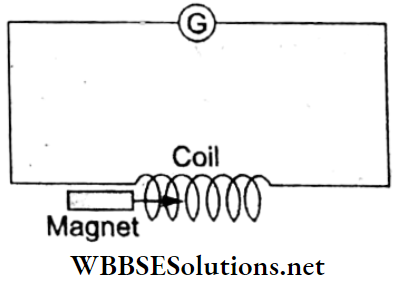
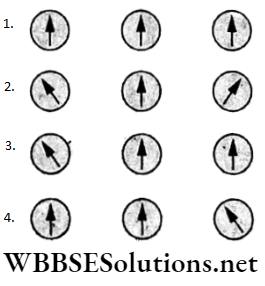
Answer: 2.
The deflection in the galvanometer follows Lenz’s law.
- When the magnet approaches the coil, the induced current opposes its motion showing the deflection towards the left.
- When the magnet is well inside the coil, the flux remains unchanged showing null deflection.
- When the magnet moves out of the coil, the direction of the induced current is reversed so as to attract the receding magnet.
This is given in option (2).
Question 70. A 30-cm-long wire of uniform cross-section with a diameter of 4 mm forming a square loop is placed in a magnetic field with its plane perpendicular to the field. If the field changes at a constant rate of 0.032 T s-1, find the current induced in the loop. (Given that the resistivity of the material of wire is 1.23 x l0-8 Ωm.)
- 0.34 A
- 0.43 A
- 0.61 A
- 0.53 A
Answer: 3. 0.61 A
Resistance of the wire is
⇒ \(R=\rho \frac{l}{A}=\rho \frac{l}{\pi r^2}\)
⇒ \(\frac{\left(1.23 \times 10^{-8} \Omega \mathrm{m}\right)\left(30 \times 10^{-2} \mathrm{~m}\right)}{(3.14)\left(2 \times 10^{-3} \mathrm{~m}\right)^2}=2.94 \times 10^{-4} \Omega\)
∴ \(I=\frac{\mathcal{E}}{R}=\frac{A d B / d t}{R}=\frac{(0.3 \mathrm{~m})^2\left(32 \times 10^{-3} \mathrm{~T}^{\prime} \mathrm{s}^{-1}\right)}{16\left(2.94 \times 10^{-4} \Omega\right)}=0.61 \mathrm{~A} .\)
Question 71. An infinitely long straight wire XY carries a steady current L A rectangular wire frame with one side open is placed in the dieplane of the straight wire. A sliding connector PQ of resistance R slides with constant velocity as shown. The current induced in the connector as a function of time is
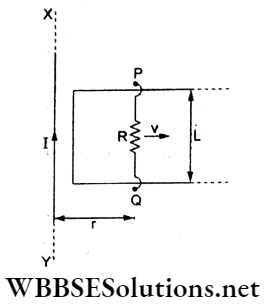
- \(\frac{\mu_0}{2 \pi} \frac{I v l}{R r}\)
- \(\frac{\mu_0}{4 \pi} \frac{I v l}{R r}\)
- \(\frac{2 \mu_0}{\pi} \frac{I v l}{R r}\)
- \(\frac{\mu_0}{\pi} \frac{\mathrm{I} v \mathrm{l}}{R r}\)
Answer: 1. \(\frac{\mu_0}{2 \pi} \frac{I v l}{R r}\)
As the connector PQ moves, it cuts the magnetic field lines produced by the straight current I. Thus, motional emf = \(B l v=\frac{\mu_0 I}{2 \pi r} v l\) is induced and current induced = \(\frac{B l v}{R}=\frac{\mu_0 I v l}{2 \pi r R}\).
Question 72. Two concentric circular coils C1 and C2 are placed in the xy-plane. C1 has 200 turns and a radius of 1 cm, C2 has 500 turns and a radius of 20 cm. Coil C2 carries a time-dependent current I(t)= (5t2-2t+3) A, where t is time in seconds. The emf induced in C1 (in mV) at t=1 s is
- \(\frac{\pi^2}{25}\)
- \(\frac{2 \pi^2}{25}\)
- \(\frac{\pi^2}{50}\)
- \(\frac{3 \pi^2}{50}\)
Answer: 2. \(\frac{2 \pi^2}{25}\)
Given, R1 = lcm, N1= 200, R2 = 20 cm, N2 = 200.
The magnetic field produced by C2 at its center is
⇒ \(B_2=\frac{\mu_0 I N_2}{2 R_2}\)
Magnetic flux linked with coil C1 is
⇒ \(\phi_1=A_1 B_2=\left(\pi R_1^2 N_1\right)\left(\frac{\mu_0 N_2}{2 R_2}\right) I(t)\)
Induced emf is
⇒ \(\varepsilon=\left|\frac{d \phi_1}{d t}\right|=\frac{\pi N_1 N_2 \mu_0 R_1^2}{2 R_2} \frac{d I(t)}{d t}\)
⇒ \(\frac{\pi(200 \times 500)\left(4 \pi \times 10^{-7}\right)\left(10^{-2}\right)^2}{2\left(20 \times 10^{-2}\right)} \cdot \frac{d}{d t}\left(5 t^2-2 t+3\right)\)
∴ \(8 \pi^2 \times 10^{-5} \mathrm{~V}=\frac{2 \pi^2}{25} \mathrm{mV}\).

